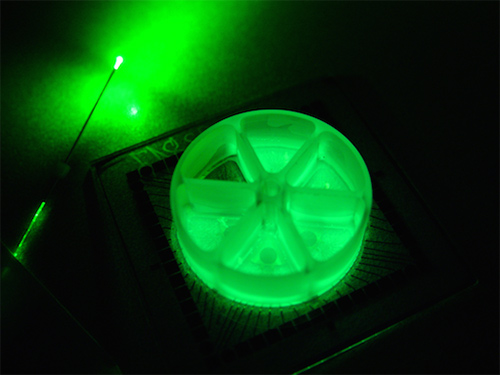![Bioluminescence from cells cultured in a multielectrode array, next to a fiber optic cable. To bypass fiber optic hardware in optogenetics—and simplify in vivo work—researchers have fused a bioluminescent protein to an inhibitory opsin. The result: an inhibitory luminopsin that can alter rat behavior. [Jack Tung]](https://genengnews.com/wp-content/uploads/2018/08/Sep30_2015_JackTung_OptogeneticsLuminopsin5015616297-1.jpg)
Bioluminescence from cells cultured in a multielectrode array, next to a fiber optic cable. To bypass fiber optic hardware in optogenetics—and simplify in vivo work—researchers have fused a bioluminescent protein to an inhibitory opsin. The result: an inhibitory luminopsin that can alter rat behavior. [Jack Tung]
Occasionally, the best way to show off is to ignore the proverb: “Don’t hide your light under a bushel.” For instance, an inner light that not only glows within but also originates there may outshine an externally supplied light—at least in optogenetics.
Although light-sensitive optogenetic probes keep improving, they still rely on external light delivery, typically via fiber optic hardware. Unfortunately, when this hardware is implanted in laboratory animals, most often in their brains, it can cause tissue damage and infection. Also, it can hinder animals’ movements, complicating behavioral studies.
To overcome these problems, researchers at Emory University and Georgia Tech have developed optogenetic tools that could allow neuroscientists to set aside the lasers and LEDs and instead deploy glowing proteins. These researchers took the enzyme luciferase from the soft coral Renilla, which glows in the presence of its substrate luciferin, and fused it to an inhibitory opsin. They called the combination an inhibitory luminopsin (iLMO).
Like previous investigators, the Emory/Georgia Tech team demonstrated that a luminopsin could alter the behavior of cultured cells. Yet the team's study also went a step further. It showed that luminopsins can modulate behavior in live animals.
This work was described September 24 in the journal Scientific Reports, in an article entitled, “Inhibitory luminopsins: genetically-encoded bioluminescent opsins for versatile, scalable, and hardware-independent optogenetic inhibition.”
“iLMO was shown to suppress action potential firing and synchronous bursting activity in vitro in response to both external light and luciferase substrate,” the study’s authors wrote. “iLMO was further shown to suppress single-unit firing rate and local field potentials in the hippocampus of anesthetized rats.”
To show that luminopsins could modulate behavior in live animals, the investigators injected a gene vector encoding their inhibitory luminopsin into the globus pallidus of rats, on just one side of the brain. Two weeks later, the rats were injected with luciferin. The globus pallidus is involved in motor control, and the presence of luciferin had the effect of disabling the globus pallidus. In response to the drug amphetamine, the animals rotated preferentially in one direction, which mimicked the behavior that results when the globus pallidus is damaged on one side.
“We chose to do the rotation tests because they were simple and easy to measure,” said biomedical student Jack Tung, who is working in the laboratory of neurosurgeon/neuroscientist Robert Gross, M.D., Ph.D. “We also wanted to show that expression of luminopsin could be scaled up to multiple structures in the brain.”
Tung and Gross are now using inhibitory luminopsins to study ways to halt or prevent seizure activity in animals. “We think that this approach may be particularly useful for modeling treatments for generalized seizures and seizures that involve multiple areas of the brain,” Tung explained. “We're also working on making luminopsins responsive to seizure activity: turning on the light only when it is needed, in a closed-loop feedback controlled fashion.”
The chemical-genetic approach to light production by luminopsins is reminiscent of DREADD (Designer Receptors Exclusively Activated by Designer Drugs) technology. Luminopsins, however, could be cleaner and easier to use, while offering scientists the choice of influencing neuronal activity with either light or an externally supplied chemical that is otherwise inert.
“With the advent of activity-dependent luciferases, luminopsin activity may be made responsive to neural activity or other biological cues in a closed-loop fashion and thus be activated only when it is needed,” the authors noted. “The luminopsin approach is thus unique in the fact that it combines the advantages of optogenetics (i.e. versatile and robust modulation of neural activity) with those of the DREADD approach (i.e. non-invasive chemical activation) into one single molecule capable of enabling responsive control of neural activity.”







